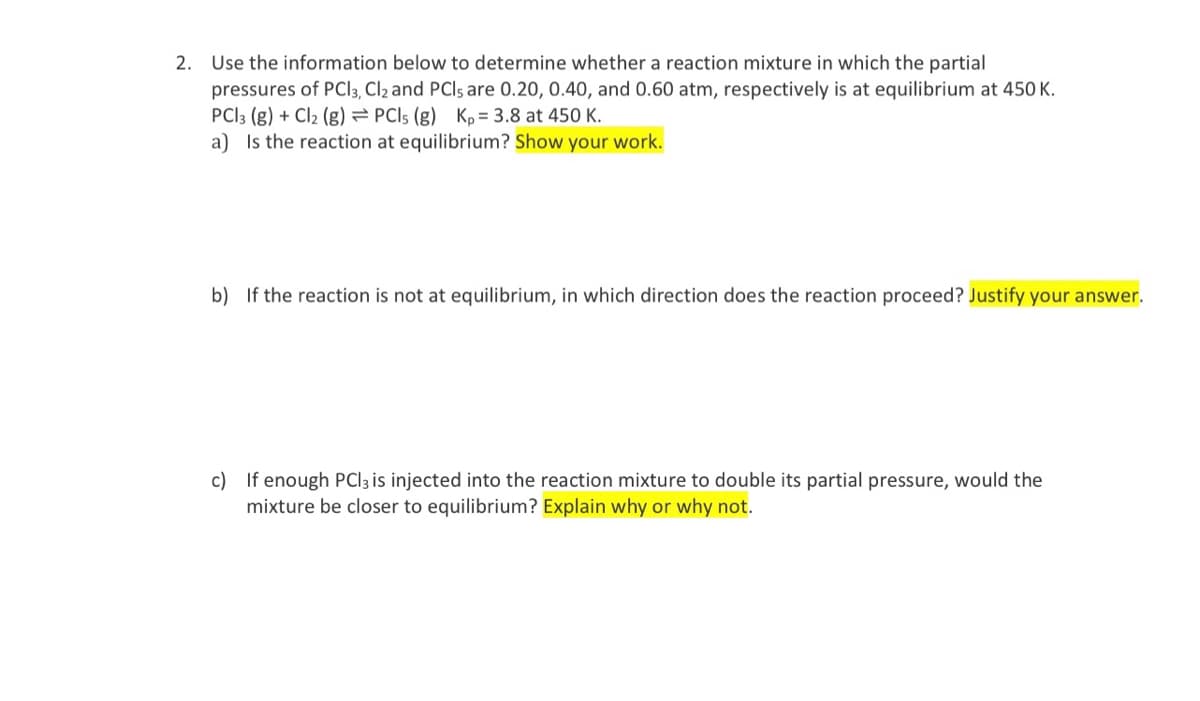2. Use the information below to determine whether a reaction mixture in which the partial pressures of PCI3, Cl2 and PCls are 0.20, 0.40, and 0.60 atm, respectively is at equilibrium at 450 K. PCI3 (g) + Cl2 (g) = PCI5 (g) Kp = 3.8 at 450 K. a) Is the reaction at equilibrium? Show your work. b) If the reaction is not at equilibrium, in which direction does the reaction proceed? Justify your answer. c) If enough PCI3 is injected into the reaction mixture to double its partial pressure, would the mixture be closer to equilibrium? Explain why or why not.
2. Use the information below to determine whether a reaction mixture in which the partial pressures of PCI3, Cl2 and PCls are 0.20, 0.40, and 0.60 atm, respectively is at equilibrium at 450 K. PCI3 (g) + Cl2 (g) = PCI5 (g) Kp = 3.8 at 450 K. a) Is the reaction at equilibrium? Show your work. b) If the reaction is not at equilibrium, in which direction does the reaction proceed? Justify your answer. c) If enough PCI3 is injected into the reaction mixture to double its partial pressure, would the mixture be closer to equilibrium? Explain why or why not.
Chemistry: Principles and Practice
3rd Edition
ISBN:9780534420123
Author:Daniel L. Reger, Scott R. Goode, David W. Ball, Edward Mercer
Publisher:Daniel L. Reger, Scott R. Goode, David W. Ball, Edward Mercer
Chapter14: Chemical Equilibrium
Section: Chapter Questions
Problem 14.29QE
Related questions
Question

Transcribed Image Text:2. Use the information below to determine whether a reaction mixture in which the partial
pressures of PCI3, Cl2 and PCIs are 0.20, 0.40, and 0.60 atm, respectively is at equilibrium at 450 K.
PCI3 (g) + Cl2 (g) = PCI5 (g) Kp = 3.8 at 450 K.
a) Is the reaction at equilibrium? Show your work.
b) If the reaction is not at equilibrium, in which direction does the reaction proceed? Justify your answer.
c) If enough PCI3 is injected into the reaction mixture to double its partial pressure, would the
mixture be closer to equilibrium? Explain why or why not.
Expert Solution
This question has been solved!
Explore an expertly crafted, step-by-step solution for a thorough understanding of key concepts.
This is a popular solution!
Trending now
This is a popular solution!
Step by step
Solved in 2 steps with 2 images

Knowledge Booster
Learn more about
Need a deep-dive on the concept behind this application? Look no further. Learn more about this topic, chemistry and related others by exploring similar questions and additional content below.Recommended textbooks for you

Chemistry: Principles and Practice
Chemistry
ISBN:
9780534420123
Author:
Daniel L. Reger, Scott R. Goode, David W. Ball, Edward Mercer
Publisher:
Cengage Learning

Chemistry & Chemical Reactivity
Chemistry
ISBN:
9781133949640
Author:
John C. Kotz, Paul M. Treichel, John Townsend, David Treichel
Publisher:
Cengage Learning

Chemistry & Chemical Reactivity
Chemistry
ISBN:
9781337399074
Author:
John C. Kotz, Paul M. Treichel, John Townsend, David Treichel
Publisher:
Cengage Learning

Chemistry: Principles and Practice
Chemistry
ISBN:
9780534420123
Author:
Daniel L. Reger, Scott R. Goode, David W. Ball, Edward Mercer
Publisher:
Cengage Learning

Chemistry & Chemical Reactivity
Chemistry
ISBN:
9781133949640
Author:
John C. Kotz, Paul M. Treichel, John Townsend, David Treichel
Publisher:
Cengage Learning

Chemistry & Chemical Reactivity
Chemistry
ISBN:
9781337399074
Author:
John C. Kotz, Paul M. Treichel, John Townsend, David Treichel
Publisher:
Cengage Learning

Chemistry
Chemistry
ISBN:
9781305957404
Author:
Steven S. Zumdahl, Susan A. Zumdahl, Donald J. DeCoste
Publisher:
Cengage Learning

Chemistry: The Molecular Science
Chemistry
ISBN:
9781285199047
Author:
John W. Moore, Conrad L. Stanitski
Publisher:
Cengage Learning

Chemistry for Engineering Students
Chemistry
ISBN:
9781337398909
Author:
Lawrence S. Brown, Tom Holme
Publisher:
Cengage Learning